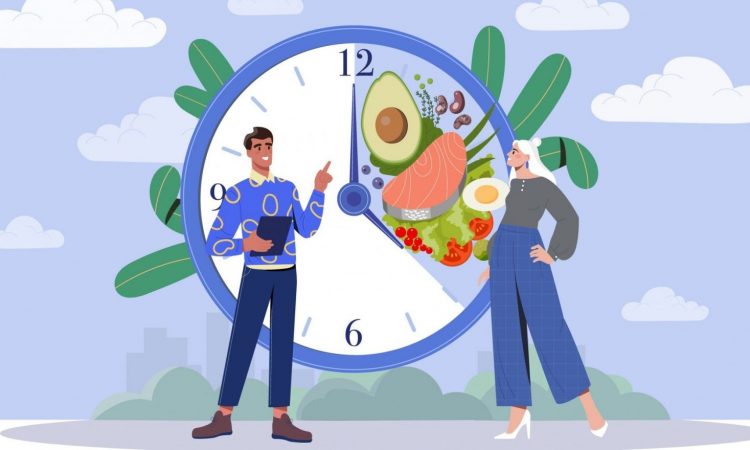Thinking about giving intermittent fasting a go? Wondering which style might suit you best? We put the two most common forms to a nutritional expert for her professional opinion.
TW: contains discussions of disordered eating.
Intermittent fasting may have been around for a while, but it seems to have come back into the mainstream recently thanks to claims it could benefit gut health. Along with eating 30 plants a week, avoiding excessive alcohol consumption and working towards stress reduction, experts often recommend giving your digestive system a total break for at least 12 hours.
You probably already fast for 12 hours without even thinking about it. All that means is finishing your dinner by 9pm and waiting to have breakfast until 9am – easy. Intermittent fasting is a little more extreme, involving going for longer periods without food and creamy drinks in the interest of balanced blood sugar, energy and digestive calm.
You may also like
Coffee should be treated as a ‘health drink’ – and cheese is great for our guts, says Dr Tim Spector
I’m a big believer in delaying the first meal of the day if you’re not working out. In my experience, waiting until after 10am to have a smoothie or cheese on toast helps with concentration, energy and hunger. If I’m doing any form of exercise in the morning, however, that obviously has to change – food allows us to fuel ahead and recover after.
But I have worked with people who insist on skipping breakfast altogether, or doing a far more intense 5:2 fast. The question is: is either approach genuinely more beneficial?
What are the scientific benefits of intermittent fasting?
First off, it’s worth exploring what the purported benefits of intermittent fasting (IF) are in the first place. “There are some potential benefits of IF for women, which include improved metabolic health markers, improved cell health and better blood sugar control due to periods of fasting without a constant insulin release,” says Reema Patel, registered dietitian and nutritionist at Dietitian Fit & Co.
“During the fasted state, cellular repair happens, which has some links to reducing inflammation and cancer biomarkers, as well as increasing stress resistance,” says Patel.

However, Patel flags the fact that more studies need to be done in humans (and particularly on women) before anything solid can be said about the benefits of IF.
“Other papers show that eating during the day can help with the circadian rhythm of the body (the internal body clock), which has been linked to reduction of chronic disease,” Patel continues.
The 5:2 fast – disordered eating or genuinely healthy?
On the face of it, the 5:2 – where you eat regularly for five days a week and a really minimal amount for two days sounds suspiciously like disordered eating. 16:8, on the other hand, involves eating whatever you like during an eight-hour period and giving your digestive system a rest for 16 hours. That might mean starting the day with water, black coffee or tea and having your first meal around midday, finishing with an 8pm dinner.
Patel says: “Some find that restricting to 25% of calories for two days of the week can be more difficult than having a time restricted fasting window, so may prefer to follow the 16:8 for a longer time period.”
She notes the fact that there’s no current evidence to suggest that any fasting regime is better than another, so recommends “choosing the fasting design based on what seems more sustainable and realistic for the long term for yourself”.
She’s also straight talking about the fact that super restrictive regimes like the 5:2 fast can lead to disordered eating patterns – potentially making it more likely to fall into a binge/restriction cycle.
“Eating this way can also be unrealistic, especially for social occasions that might happen on those two low-food days.” Patel warns that it’s also unsuitable for anyone who leads an active lifestyle and who needs to refuel post-workout… which ideally should be most of us.
We know that calorie restriction can put stress on the body – and that can cause all kinds of havoc with hormonal regulation, blood sugar levels, insulin resistance etc. Stick at it long enough and you could potentially find yourself struggling with RED-S (relative energy deficiency in sports), which can lead to period loss and fertility issues.
How to try intermittent fasting safely
Fasting can be helpful for some but the key is trying to avoid extreme behaviour and knowing what extreme means to you. Someone might never eat breakfast and feel totally fine; others wouldn’t make it past 9am without feeling faint. Here’s how to give it a go if you are interested.
Start with a 12-hour fasting window
“Start off with a 12- to 14-hour fast to see how you feel with this, before slowly trying to increase this to 16 hours,” Patel recommends.
Eat properly balanced meals
It’s really important with fasting that the meals you do eat are filling, nourishing and properly balanced. That means having a load of complex carbs, good sources of protein, plenty of plants and a decent dose of fats.
Stay hydrated
Keep well hydrated with plenty of water and start or end your day with black (or decaf) coffee and herbal teas.
Be prepared to stop fasting if it doesn’t work for you
“If you find that this pattern of eating is not fitting into your lifestyle, it may not be for you and that’s totally OK! It’s not the holy grail of health, but for some it can work well and provide some researched health benefits,” Patel says. Again, just remember that the research on the benefits for women isn’t yet fully confirmed.
Before trying any kind of fasting, it’s worth seeking professional advice. People who are under 18, pregnant or living with type 1 diabetes should avoid fasting – as should anyone with a history of disordered eating. If you are struggling with food and body image, check out Beat and the charity’s free helpline on 0808 801 0677 (England).
Images: Getty
Source: Read Full Article
